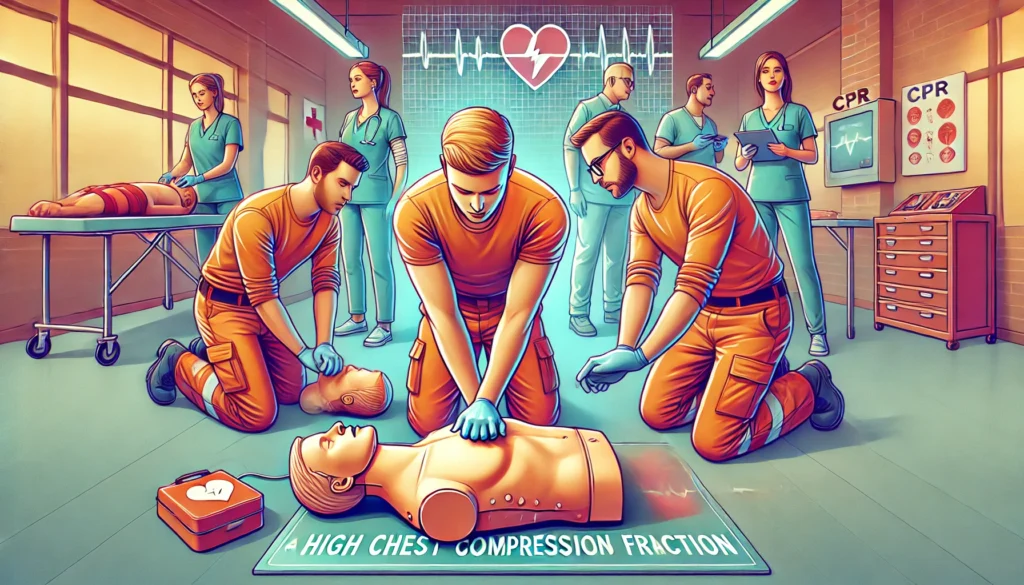Hey there! Let’s dive into something super important – how can you achieve a high chest compression fraction (CCF). I know it sounds a bit technical but stick with me. By the end of this, you’ll feel like a CPR pro. Ready? Let’s get started!
Table of Contents
What’s Chest Compression Fraction Anyway?
First things first: what on earth is CCF? In simple terms, CCF is a measure of how much time during CPR is spent actively doing chest compressions. Picture it like this: if you’re performing CPR for a minute, and 50 seconds of that is spent compressing the chest, your CCF is 83%. Easy, right?
Why does this matter? Because uninterrupted chest compressions are the golden ticket for keeping blood flowing to the brain and heart during a cardiac arrest. The higher your CCF, the better the chances for survival. So yeah, it’s a pretty big deal.
Why Should You Aim for a High CCF?
Alright, here’s the deal. Imagine your heart’s a pump. When it stops, your chest compressions take over that job. But if you’re constantly stopping to do other things, you’re not pumping blood effectively. That’s bad news for the person you’re trying to save.
Studies have shown that higher CCF equals better survival rates. More blood flow means more oxygen getting to vital organs. And you don’t need to be a doctor to know that’s a good thing.
How Do You Nail a High CCF?
Let’s break it down step by step. Whether you’re a newbie or a seasoned rescuer, these tips will help you maximize your CCF:
Prioritize Compressions
CPR is all about those chest compressions. Here’s how you keep the focus where it belongs:
- Minimize Interruptions: Avoid stopping unless you have to. Things like rhythm checks, rescuer swaps, or giving breaths? Keep ‘em short and sweet.
- Avoid Overdoing Ventilations: Yes, giving breaths is important, but overdoing it can hurt more than help. Stick to the recommended guidelines.
Get the Team on the Same Page
If you’re not flying solo, teamwork makes the dream work. Here’s how:
- Smooth Transitions: When switching roles, time it so there’s minimal downtime. Think of it like a relay race – the handoff has to be quick and seamless.
- Clear Roles: Everyone should know their job. One person leads, and others follow. Communication is key, folks.
Perfect Your Technique
High-quality compressions are non-negotiable. Here’s what that looks like:
- Hand Placement: Keep your hands on the center of the chest, right over the lower half of the sternum.
- Depth and Rate: Go at least 2 inches deep at a steady 100-120 compressions per minute. Think of the beat of “Stayin’ Alive.” Yes, that’s a real CPR trick.
- Full Recoil: Let the chest rise back up fully between compressions. No leaning, okay?
Consider Mechanical Help
Sometimes, a little tech can go a long way. Mechanical CPR devices can keep compressions consistent when humans can’t. They’re especially handy in situations where rescuers are fatigued or conditions are tricky.
Challenges You Might Face
Okay, let’s keep it real. Achieving a high CCF isn’t always easy. Fatigue, confusion in team settings, or just plain old panic can get in the way. The trick? Practice and preparation.
- Practice Makes Perfect: The more you practice, the more muscle memory kicks in. When the real deal happens, you’ll be ready.
- Stay Calm: Easier said than done, I know. But keeping a cool head can make all the difference.
The Bigger Picture
At the end of the day, CPR isn’t just about compressions. It’s about giving someone a fighting chance. High-quality, uninterrupted chest compressions are the foundation of effective CPR. So, the next time you’re called to action, remember this: every second of compression counts.
Quick Recap
Here’s the cheat sheet for achieving a high CCF:
- Minimize Interruptions: Less pausing, more compressing.
- Coordinate Team Efforts: Work together like a well-oiled machine.
- Focus on Technique: Depth, rate, and recoil are your best friends.
- Leverage Tech When Needed: Don’t hesitate to use mechanical devices if they’re available.
Final Thoughts
You’ve got this! Whether you’re a seasoned pro or learning CPR for the first time, the key is to focus on what matters: keeping those compressions going. It’s not just a skill – it’s a lifesaver.
So, next time someone asks, “How can you achieve a high chest compression fraction?” you’ll know exactly what to say.

